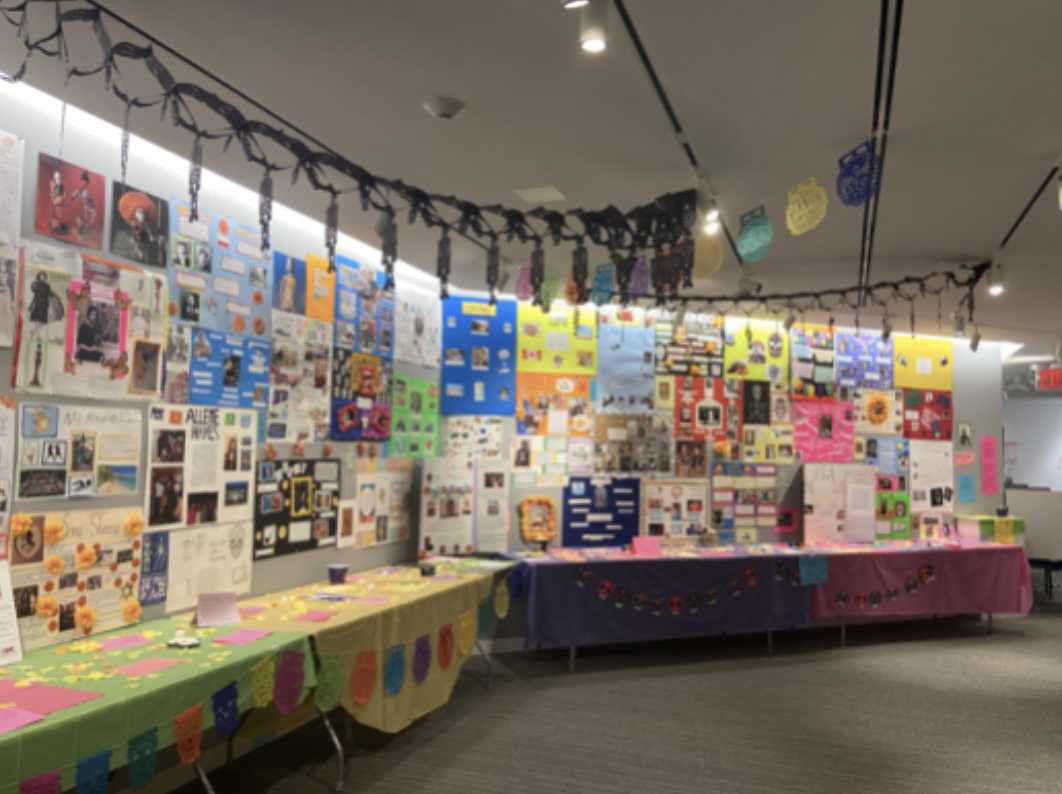Catching the attention of everyone who walks through the Tate Library, the Dia de Los Muertos exhibit is truly spectacular. The exhibit features a colorful display of student posters that honor the losses of those who were close to students or their families. The exhibit is visually beautiful, but the meaning behind it is just as special.
El Día de Los Muertos is a Mexican holiday that originated from a combination of indigenous Mexican culture as well as European culture. The indigenous people in Mexico viewed death as an important part of life, believing that souls lived on in a spiritual afterlife, known as the Land of the Dead. They practiced human sacrifices and celebrated death. Additionally, in medieval Spain, death was also celebrated. On All Souls Day, a Catholic holiday, Spaniards would go to the graveyard to visit the graves of their loved ones. Thus, after its colonization, Mexico had a blend of both indigenous and European cultures.
El Día de Los Muertos is the day when the border between the living world and the dead world is broken. Families will go to the graveyard to visit the graves of their loved ones, as it is believed that their souls come back to the living world. Families bring candles to the graveyard in order to provide light to guide their relatives back to them. The picnics include foods such as pan de Muerto (a traditional sweet bread), tamales (corn husks with filling inside), ponche (a punch made out of fruit) and atole (a warm drink made out of corn). Traditionally, families will make ofrendas, or altars, for their deceased loved ones. The ofrendas are made differently by each family, but most have photos of the person’s favorite foods, candles, cempasúchil flowers and anything else that the person liked. On El Día de Los Muertos, the deceased relative returns to the altar and enjoys the various items on the ofrenda.
The exhibit in the Tate has been a Fieldston tradition for 20 years. It began in 2001, when Spanish teachers Maura Furfey and Alice Montera decided to create an ofrenda to honor those lost in the attacks on September 11th. Today, Form III students create posters in memory of their relatives or loved ones who have passed. The goal, according to Furfey, is to make the posters as colorful and vibrant as possible. In the days leading up to El Día de Los Muertos, students learn the vocabulary words related to the holiday and also study past tense conjugations in order to write about past lives. The idea is to have students talk to their family members about this person and share memories of them. Although Senora Montera no longer teaches at Fieldston, she came back to surprise Furfey this year so that they could both set up the exhibit together.
In the fall of 2019, Furfey and Montera had the opportunity to travel to Guanajuato, Mexico, for El Día de los Muertos. “It was truly spectacular,” said Furfey. There were ofrendas all over the city, as well as alfombras, which are traditional Guatemalan carpets made out of sawdust. “When El Día de Los Muertos is over, they just come in and sweep the alfombras all up and they’re gone. It’s symbolic because everything is temporary and that’s part of the whole point of the holiday,” she said. They attended carnivals, one of which even had real mummies on display. They also went to a festival hosted by an organization that helps women who have been through domestic violence, which was super emotional. The day after the holiday, they visited a cemetery (they did not want to go the night before to disturb the families celebrating), and “it was a profound moment” for Furfey.
Furfey hopes that the exhibit in the Tate will be recognized as more than just a beautiful sight. “I hope that it gives people a chance to pause and think about anyone in their own lives who may have passed. Having an intentional moment to think feels very healing, especially after this last year and a half. It’s horrendous to think about all of the deaths. It’s been a tough few years for us as a community, and I hope that even if we aren’t thinking about someone in particular, we are still taking a moment to think about all of the people who have passed and remember them.” Additionally, she hopes that people recognize the holiday itself as well as the history behind it. In recent years, the holiday has been capitalized on in America, and its history and meaning are ignored. “This is a Latin American holiday, and this country is filled with immigrants who are often put in the shadows,” Furfey said. The exhibit is meant to honor those immigrants as well as the indigenous people who created El Día de Los Muertos.






